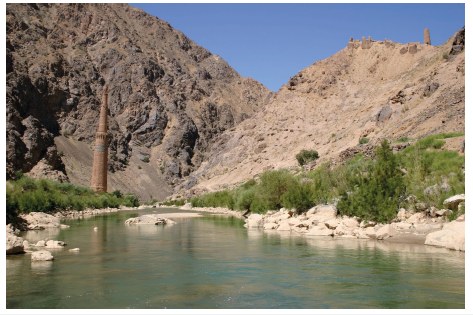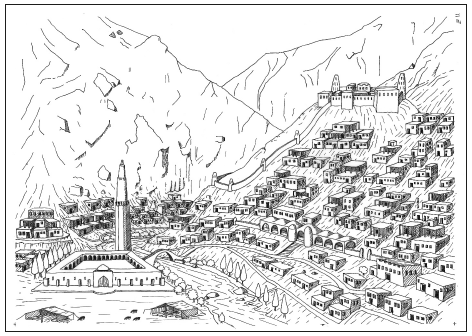- Submissions

Full Text
Archaeology & Anthropology:Open Access
Beyond the Archaeology of Despair in Afghanistan
David C Thomas*
Department of Archaeology and History, Australia
*Corresponding author:David C Thomas, Honorary Research Associate, Department of Archaeology and History, Australia
Submission: June 19, 2019;Published: June 24, 2019

ISSN: 2580-1949 Volume3 Issue2
Opinion
Not much good news has come out of Afghanistan since the Soviet invasion in 1979. In addition to the vicious conflicts, humanitarian crises, diaspora, explosion in drug cultivation, use and trafficking, and the associated corruption, Afghanistan’s rich archaeological and cultural heritage has been devastated. Remarkable Greco-Bactrian cities such as Aï Khanoum have been systematically looted on an industrial scale, while the Buddhas of Bamiyan were blown up by the Taliban in 2001. Even Kabul Museum was caught in the crossfire between rival militia and then ransacked by looters and iconoclasts.
Just a few days ago, one of the fortification towers in the medieval city walls at Ghazni collapsed [1], while a month ago floods threatened the magnificent UNESCO World Heritage listed Minaret of Jam (Figure 1). Exacerbating the threats from nature, the Taliban killed 18 people near Jam, who were protecting workers trying to divert the flood waters away from the minaret [2].
Figure 1:The Minaret of Jam (©David Thomas 2005/ Minaret of Jam Archaeological Project).

Amidst this catalogue of carnage, it would be easy to despair about the future of archaeology in Afghanistan. But as the recently revised Archaeological Gazetteer of Afghanistan reminds us, to do so would be premature and short-sighted [3]. The astonishingly rich archaeology of Afghanistan has endured threats and destruction for millennia, and it still has the power to dazzle and amaze us - the tens of thousands of people who saw the touring Hidden Treasures from the National Museum, Kabul exhibition at different venues around the world can testify to that [4].
In the light of this, it is worth highlighting some of the impressive achievements of archaeologists, architectural historians and museum employees working in Afghanistan and overseas on Afghan material. The French Archaeological Delegation in Afghanistan (DAFA) has led the way in archaeological work in Afghanistan since the 1922 [5]. Their pioneering work, particularly in Bactria, in the north of the country, brought to the world’s attention spectacular sites such as Aï Khanoum. More recently, they have focused on Buddhist sites, such as Mes Aynak, which is threatened by the proposed development of a copper mine. An award-winning documentary by Brent Huffman documents the challenges and threats facing those who are trying to save the site [6].
On the other side of the country, the German Afghan Archaeological Mission to Afghanistan has undertaken extensive surveys in and around Herat. They have also excavated and restored parts of the huge multi-period citadel in Herat and published several impressive tomes of research [7]. German archaeologists also worked with the Aga Khan Trust for Culture on the restoration of the Gardens of Babur in Kabul [8], while the Aga Khan Trust for Culture and the Turquoise Mountain Foundation have focused on reviving Afghanistan’s arts and architecture through restoration projects and vocational training [9]. Similarly, the Afghanistan Cultural Heritage Consulting Organization is working on several documentation and restoration projects, including one at Topdara, one of the best-preserved of the Buddhist complexes in the region [10].
Taking a different approach, the Oriental Institute in Chicago, DAFA and others have used satellite imagery to discover and map thousands of archaeological sites across the country [11,12]. Detailed analysis of satellite images has shown that, as well as looting and warfare, uncontrolled urban development and agriculture pose major, incremental threats to archaeological sites [13]. The Oriental Institute has also undertaken major capacity building projects with the National Afghan Institute of Archaeology and the National Museum, teaching Afghan archaeologists and museum curators twenty-first-century skills [14].
In 2017, United Nations Assistance Mission in Afghanistan used drones and digital photography to scan the Minaret of Jam, while laser scanners have recorded the eleventh century Ghaznavid towers at Ghazni [15,16]. Digital technology could also be used to create 3D reconstructions of sites such as Jam and Ghazni, building on recent fieldwork to re-imagine what these thriving ancient cultural centers may have looked like (Figure 2).
Figure 2:A reconstruction of what the Ghurid summer capital around the minaret of Jam may have looked like (©artist: Catriona Bonfiglioli/Minaret of Jam Archaeological Project).

The Soviet invasion and its aftermath may have severely curtailed archaeological fieldwork in Afghanistan, but a wealth of discoveries and publications (some freely available over the internet) [17] continue to highlight the spectacular wealth and importance of Afghanistan’s archaeological and cultural heritage. As Morwari [18] has recently argued, Afghanistan’s heritage is important if the country is to build a peaceful future - so, rather than despair, Afghanistan needs internationally funded, robust, sustainable cultural heritage protection and educational programs more than ever.
Dr David Thomas is an Honorary Researcher at the Department of Archaeology and History, La Trobe University, Australia. His recent book on the archaeology surrounding the Minaret of Jam and the Ghurid Empire is published through Sydney University Press [19].
References
- h t t p : / / p r o d . t o l o n e w s . c o m / a r t s - c u l t u r e / h i s t o r i c - t o w e r - collapses-ghazni?fbclid=IwAR3EfBYoh4y1GSlRgh50MoOdOggkp_ XsMMG1cfgeYvVfIQKODU7Qei2iM1c.
- After Centuries Of Neglect, Afghanistan’s Historic Minaret Under Threat From Taliban.
- https://global.oup.com/academic/product/archaeological-gazetteerof- afghanistan-9780199277582?cc=au&lang=en&
- https://www.metmuseum.org/exhibitions/listings/2009/afghanistan/ photo-gallery.
- https://news.cnrs.fr/articles/saving-afghanistans-incredible-heritage.
- http://www.savingmesaynak.com/.
- http://ancient-herat.de/home.
- https://www.akdn.org/where-we-work/central-asia/afghanistan/ cultural-development/restoration-kabul.
- https://turquoisemountain.org/afghanistan.
- http://www.achco.org.af/
- https://www.researchgate.net/publication/313684816_On_the_ Margins_Enduring_Pre-Modern_Water_Management_Strategies_In_and_ Around_the_Registan_Desert_Afghanistan
- https://oi.uchicago.edu/sites/oi.uchicago.edu/files/uploads/shared/ docs/Research/Franklin%20and%20Hammer2018%20copy.pdf
- h t t p s : / / w w w. s c i e n c e d i r e c t . c o m / s c i e n c e / a r t i c l e / p i i / S2212054818300201
- https://oi.uchicago.edu/research/camel/afghan-heritage-mappingpartnership
- h t t p s : / / w w w . y o u t u b e . c o m / w a t c h ? v = P c E 1 0 V s q P 5 Q & f e a t u r e = s h a r e & u t m _ content=bufferb32ad&utm_medium=social&utm_source=twitter. com&utm_campaign=buffer
- https://eca.state.gov/files/bureau/ghazni-towers/index.html#header
- The Oriental Institute’s Preserving the Cultural Heritage of Afghanistan, which includes 24 papers by Afghan and international scholars.
- https://gandhara.rferl.org/a/cultural-preservation-paves-the-way-topeace- in-afghanistan/29993562.html
- http://purl.library.usyd.edu.au/sup/9781743325414
© 2019 David C Thomas. This is an open access article distributed under the terms of the Creative Commons Attribution License , which permits unrestricted use, distribution, and build upon your work non-commercially.
 a Creative Commons Attribution 4.0 International License. Based on a work at www.crimsonpublishers.com.
Best viewed in
a Creative Commons Attribution 4.0 International License. Based on a work at www.crimsonpublishers.com.
Best viewed in 







.jpg)






























 Editorial Board Registrations
Editorial Board Registrations Submit your Article
Submit your Article Refer a Friend
Refer a Friend Advertise With Us
Advertise With Us
.jpg)






.jpg)














.bmp)
.jpg)
.png)
.jpg)










.jpg)






.png)

.png)



.png)






